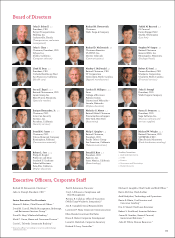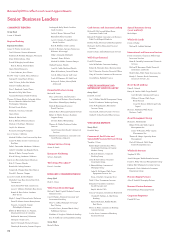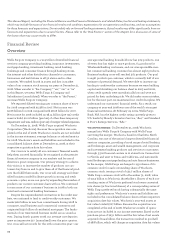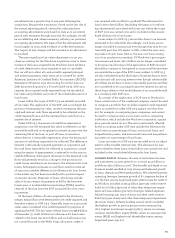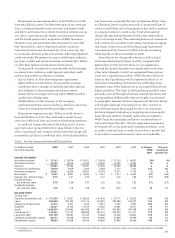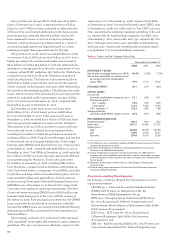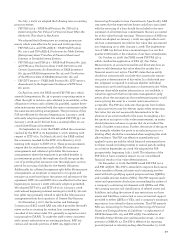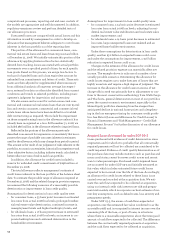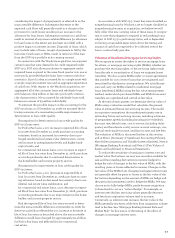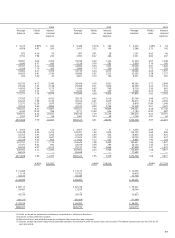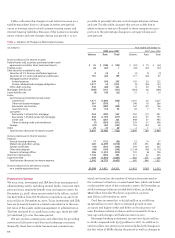Wells Fargo 2008 Annual Report Download - page 42
Download and view the complete annual report
Please find page 42 of the 2008 Wells Fargo annual report below. You can navigate through the pages in the report by either clicking on the pages listed below, or by using the keyword search tool below to find specific information within the annual report.Because the FSP amends only the disclosure requirements,
the adoption of the FSP did not affect our consolidated finan-
cial results. For additional information, see Note 8
(Securitizations and Variable Interest Entities).
On September 12, 2008, the FASB issued FSP FAS 133-1
and FIN 45-4. This FSP is intended to improve disclosures
about credit derivatives by requiring more information about
the potential adverse effects of changes in credit risk on the
financial position, financial performance and cash flows of
the sellers of credit derivatives. It amends FAS 133,
Accounting for Derivative Instruments and Hedging Activities,
to require disclosures by sellers of credit derivatives, includ-
ing credit derivatives embedded in hybrid instruments. The
FSP also amends FIN 45, Guarantor’s Accounting and
Disclosure Requirements for Guarantees, Including Indirect
Guarantees of Indebtedness to Others – an interpretation of
FASB Statements No. 5, 57, and 107 and rescission of FASB
Interpretation No. 34, to require an additional disclosure
about the current status of the payment/performance risk of
a guarantee. The provisions of the FSP that amend FAS 133
and FIN 45 are effective for reporting periods (annual or
interim) ending after November 15, 2008. Because the FSP
amends only the disclosure requirements for credit deriva-
tives and certain guarantees, the adoption of the FSP did not
affect our consolidated financial results.
On October 14, 2008, the SEC’s Office of the Chief
Accountant (OCA) clarified its views on the application
of other-than-temporary impairment guidance in FAS 115,
Accounting for Certain Investments in Debt and Equity
Securities, to certain perpetual preferred securities. The OCA
concluded that it would not object to a registrant applying an
other-than-temporary impairment model to investments in
perpetual preferred securities that possess significant debt-like
characteristics that is similar to the impairment model applied
to debt securities, provided there has been no evidence of
deterioration in credit of the issuer. An entity is permitted to
apply the OCA’s views in its financial statements included in
filings subsequent to the date of the letter. Accordingly, in third
quarter 2008, we began applying this OCA guidance and have
subsequently recorded other-than-temporary impairment on
certain investment grade perpetual preferred securities where
we believe credit events of the issuers have occurred.
On January 12, 2009, the FASB issued FSP EITF 99-20-1,
which amends EITF 99-20, Recognition of Interest Income and
Impairment on Purchased Beneficial Interests and Beneficial
Interests That Continue to Be Held by a Transferor in
Securitized Financial Assets (EITF 99-20), to achieve more
consistent determinations of whether other-than-temporary
impairments of available-for-sale or held-to-maturity debt
securities have occurred. The provisions of the FSP are to be
applied prospectively and are considered effective for report-
ing periods (annual or interim) ending after December 15,
2008. Beginning with our fourth quarter 2008 results, based
on this FSP guidance, we recorded no other-than-temporary
impairment for certain EITF 99-20 securities that otherwise
may have been considered impaired.
On December 4, 2007, the FASB issued FAS 141 (revised
2007), Business Combinations (FAS 141R). This statement
requires an acquirer to recognize the assets acquired (includ-
ing loan receivables), the liabilities assumed, and any non-
controlling interest in the acquiree at the acquisition date, to
be measured at their fair values as of that date, with limited
exceptions. The acquirer is not permitted to recognize a sepa-
rate valuation allowance as of the acquisition date for loans
and other assets acquired in a business combination. The
revised statement requires acquisition-related costs to be
expensed separately from the acquisition. It also requires
restructuring costs that the acquirer expected but was not
obligated to incur, to be expensed separately from the busi-
ness combination. FAS 141R is applicable prospectively to
business combinations completed on or after January 1, 2009.
Early adoption is not permitted.
In December 2008, the FASB issued FAS 160, Noncontrolling
Interests in Consolidated Financial Statements – an amendment
of ARB No. 51 (FAS 160). FAS 160 requires that noncontrolling
interests (referred to as minority interests) be reported as a
component of stockholders’ equity in the balance sheet. Prior
to adoption of FAS 160 they are classified in liabilities or
between liabilities and stockholders’ equity. This new standard
also changes the way a minority interest is presented in the
income statement such that a parent’s consolidated income
statement includes amounts attributable to both the parent’s
interest and the noncontrolling interest. FAS 160 requires
that a parent recognize a gain or loss when a subsidiary is
deconsolidated. The remaining interest is initially recorded
at fair value. Other changes in ownership interest where the
parent continues to have a majority ownership interest in the
subsidiary are accounted for as capital transactions.
FAS 160 is effective for fiscal years and interim periods
within fiscal years, beginning on or after December 15, 2008.
Early adoption is not permitted. Adoption is applied prospec-
tively to all noncontrolling interests including those that
arose prior to the adoption of FAS 160, with retrospective
adoption required for disclosure of noncontrolling interests
held as of the adoption date.
We hold a controlling interest in a joint venture with
Prudential Financial, Inc. (Prudential) as described in more
detail on page 57. Prudential’s noncontrolling interest of
23% is included in other liabilities in the balance sheet, and
amounted to $824 million at December 31, 2008. Under the
terms of the original agreement under which the joint ven-
ture was established between Wachovia and Prudential, each
party has certain rights such that changes in our ownership
interest can occur. Prudential has stated its intention to exer-
cise its option to put its noncontrolling interest to us at a date
in the future.
As a result of the issuance of FAS 160 and related inter-
pretive guidance, along with this stated intention, in the first
quarter of 2009, the carrying value of Prudential’s noncon-
trolling interest in the joint venture will be increased from its
December 31, 2008, carrying value to the estimated maximum
redemption amount, with the offset recorded to additional
paid-in capital.



